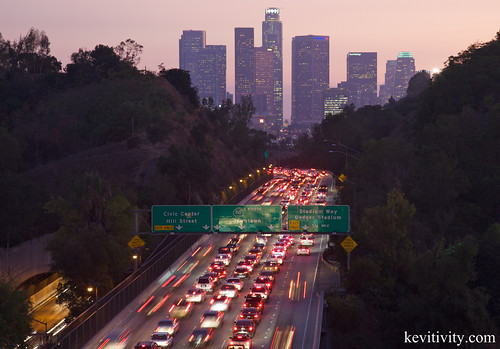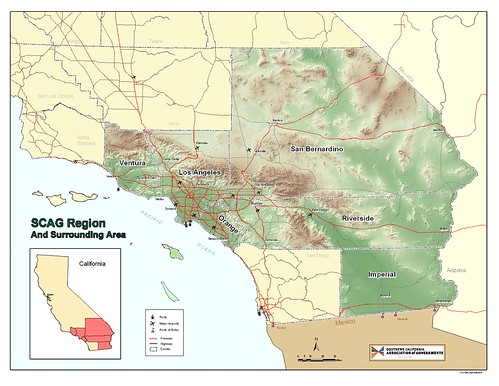SoCal's new sustainability strategy is impressive step forward

Posted April 12, 2012 at 1:31PM
We expect forward-looking sustainability planning from places like Portland, Vancouver and Copenhagen. Los Angeles? Not so much. Southern California is a region much better known for environmental problems than solutions, which is precisely why its new, 25-year Sustainable Communities Strategy, adopted unanimously last week by the Southern California Association of Governments (SCAG), is so significant.
SCAG is the nation's largest metropolitan planning organization, representing six counties: Los Angeles, Orange, San Bernardino, Riverside, Ventura and Imperial. Its planning area covers an astounding 38,000 square miles, including 191 cities and more than 18 million residents. If southern California were a state, it would be the 5th most populous in the nation. If it were a country, it would have the world’s 16th largest economy.
In an area renowned for clogged freeways and sprawl, the region’s sustainability challenges are immense. Riverside-San Bernadino, for example, claimed the number one spot as the nation’s most sprawling metro area in Smart Growth America’s definitive 2002 study, Measuring Sprawl and its Impact. In a separate index, the southern California area was identified by the Brookings Institution (using 2006 data) as having the nation’s highest rate of driving per person volume of traffic on arterial roadways. The transportation analysis firm INRIX, which issues an annual “National Traffic Scorecard,” ranks the region as also having the nation’s worst traffic congestion, based on sophisticated measurements of travel delays. Indeed, five of the nation’s ten most congested freeway corridors, INRIX reports, are located in Southern California.
Perhaps unsurprisingly, the region’s air quality is notorious: it is the worst in the country for pollution by ozone smog, which can impair breathing function, according to the American Lung Association. It is the second worst for particle pollution, which causes heart and lung disease and premature death. In addition, two southern California counties – Los Angeles and Orange – are among the nation’s 20 riskiest for developing cancer from breathing toxic air pollution, according to the federal Environmental Protection Agency. The region is fifth worst for per capita carbon emissions from transportation (though its mild climate and resulting low residential energy demands help keep overall emissions relatively low).
While the environmental facts are daunting, the good news is that the region is doing something about it.
Last week, after years of preparation, SCAG adopted its first-ever Sustainable Communities Strategy. The new plan is impressive, relying on increased investment in public transit and more walkable, transit-accessible land use patterns to reduce pollution while conserving farmland and natural areas. Indeed, the strategy has been hailed by my California-based colleague (and NRDC’s deputy director for sustainable communities) Amanda Eaken as a “roadmap to cleaner air and a healthier economy” for the region’s residents and visitors. These are some of its highlights:
 The new strategy will invest $246 billion in public transportation
The new strategy will invest $246 billion in public transportation- It will fund 12 major transit expansion projects in Los Angeles over the next 10 years, under LA Mayor Villaraigosa’s 30-10 plan
- It will increase funding for bicycling and walking over threefold, from $1.8 to $6.7 billion
- It is projected to reduce traffic congestion 24 percent per capita despite the addition of four million residents
- It will place 60 percent more housing in transit-accessible locations
- It will create 4.2 million jobs in the region, and place 87 percent of all jobs within a half mile of transit service
- It is projected to reduce pollution-caused respiratory problems by 24 percent, resulting in $1.5 billion per year in health care savings
- It will save over 400 square miles of farmland and other open space from development
For all the details, go here.
Amanda’s blog entry quotes Jane Warner, President and CEO of the American Lung Association in California, as calling the new plan “the best prescription for improving the health of all Southern California residents.” That’s a pretty significant endorsement from a pretty significant source.
SCAG Executive Director Hasan Ikhrata told Andrew Dalton of the Associated Press that “this plan looked at land use for the first time since we started doing planning.” That’s fairly amazing for the largest metro planning agency in the country, but Ikhrata and his colleagues deserve our praise and thanks for doing so now. Dalton summarized the moment:
“The government group that oversees transportation for Southern California voted Wednesday to approve a $524 billion agreement that aims to make train tracks, bike lanes and clear skies as much a part of the region's image as boulevards and freeways.
“The unanimous vote from the Southern California Association for the 25-year Regional Transportation Plan provided a moment of consensus and celebration for the government officials and advocates who worked on it for four years, a feeling that could fade as it now needs to be put into play by local agencies and paid for by citizens.
“Still, the plan, a blueprint of priorities created by the group's 191 cities based on the federal, state and local funding the region expects to see, represents a huge shift in emphasis.”
Dalton’s story was reported in the San Francisco Chronicle.
The new plan, which will be updated every four years, was required by California’s landmark planning law, Senate Bill 375, passed and signed into law in 2008. SB 375 requires that a Sustainable Communities Strategy to reduce carbon pollution be incorporated into regional transportation planning. NRDC strongly supported the law and has been working on its implementation.
Related posts:
- California air board sets enforceable targets for smart planning (September 28, 2010)
- New California report shows well-planned land use could dramatically reduce pollution, household costs (June 24, 2010)
- ULI gives strong endorsement to California smart growth law (June 10, 2010)
- How the new California smart growth law will work (October 15, 2008)
- NY Times applauds California smart growth law (October 7, 2008)
Move your cursor over the images for credit information.
Please also visit NRDC’s Sustainable Communities Video Channel.

